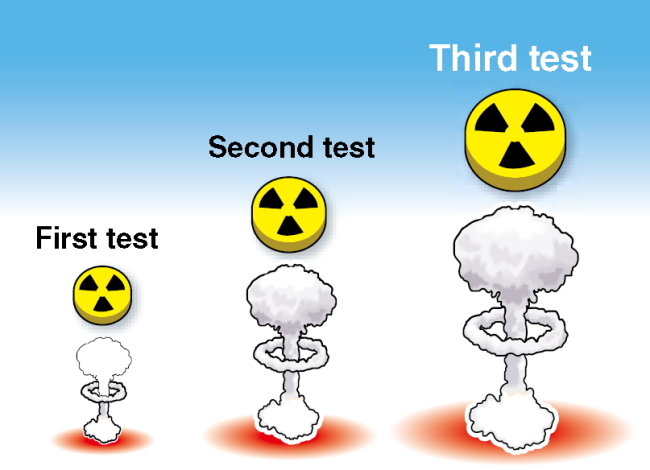
The power of the device used in North Korea’s third nuclear test fell short of expectations based on Pyongyang’s earlier statements, fueling concerns for further tests.
“If it was a high-standard test North Korea claimed, it should have been more than 10 kilotons, but it fell short of that mark. It is lower even than the explosive power (Seoul) has been estimating” an anonymous military official was quoted as by local news agency. The high-standard test refers to Pyongyang’s Jan. 24 threat of conducting a “high-standard nuclear test aimed at the United States.”
“There were analysis that North Korea could use a boosted fission weapon but the yield falls far short of a boosted fission weapon.”
According to data collected by South Korean authorities, the nuclear test generated seismic activity of 4.9 magnitude, which is estimated to equate to yield of between 6 and 7 kilotons. Seoul, however, had initially said that an artificial earthquake of magnitude 5 was detected and that estimated yield of the device to be about 10 kilotons.
In comparison, the first nuclear test conducted by Pyongyang in October 2006 generated 3.6 magnitude seismic activity and is estimated to have had a yield of 1 kiloton.
The yield of the device used in the second test of May 2009 is estimated to have ranged between 2 kilotons and 6 kilotons, and a 4.9 magnitude seismic activity was detected by South Korean authorities.
While the yield of the device used in the latest test was larger than those previously, it falls far short of the nuclear devices dropped on Japan in 1945.
The yield of the devices dropped on Nagasaki and Hiroshima at the end of WWII were 22 kilotons and 13 kilotons, respectively.
North Korea, however, claimed that Tuesday’s test was of a “high-standard,” saying that the device used was smaller than those used in previous tests.
“Unlike previous times, a smaller and lighter nuclear bomb with more explosive power was used to conduct a high-standard nuclear test safely,” Pyongyang’s Korean Central News Agency said Tuesday. The agency also said that the test was conducted “perfectly without any negative impact on the surrounding environment.”
By Choi He-suk
(cheesuk@heraldcorp.com)
<관련 한글 기사>
북한 핵 위력, 생각보다 약해
북한이 12일 강행한 제3차 핵실험의 위력이 기존 예상을 밑도는 것으로 추정되어 추가 핵실험이 이뤄질지 여부가 주목되고 있다.
연합 뉴스 보도에 따르면, 군 관계자는 “북한이 주장한 높은 수준의 핵실험이라면 10kt 이상은 돼야 하는데 거기에 못 미치는 규모”라면서 기존에 예상되었던 폭발력에도 미치지 못한다고 설명했다.
이는 이번 핵실험의 위력이 북한이 지난달 24일 외무성 발표를 통해 주장한 ‘높은 수준의 핵실험’에 미치지 못한다는 의미이다.
이 당국자는 “북한이 이번에 증폭핵분열탄(boosted fission weapon)으로 핵실험을 할 수 있다는 분석도 있었지만 폭발력으로 추정했을 때 증폭핵분열탄에 훨씬 미치지 않는다”고 덧붙였다.
기상청이 분석한 바에 따르면 이번 핵실험은 함경북도 길주군 풍계리 근처를 진앙지로 진도 4.9 규모의 인공지진파를 발생시켰다고 한다. 당국은 이를 토대로 이번 핵 실험의 폭발력이 6에서 7킬로톤 정도일 것으로 추정했다.
2006년 10월 실시한 1차 핵실험의 경우 인공지진파의 진도는 약 3.6, 그 위력은 1킬로톤으로 분석되었으며, 2009년 2차 핵실험 때는 지진파가 4.9, 위력은 2에서 6킬로톤 사이로 분석되었다.
즉, 이번 핵실험의 위력은 지난 2번의 핵실험보다는 크지만 2차 세계대전 당시에 미국이 일본에 투하한 핵폭탄의 위력보다 약한 것이다. 당시 나가사키에 투하된 폭탄은 22킬로톤, 히로시마의 투하된 폭탄의 위력은 13킬로톤에 달했다.
한편 북한은 이날 오후 2시 43분에 조선중앙통신을 통해 제3차 지하핵실험이 성공적으로 진행되었다고 선포했다.
북한은 “이전과 달리 폭발력이 크면서도 소형화, 경량화된 원자탄을 사용하여 높은 수준에서 안전하고 완벽하게 진행됐다”라고 주장하였다. (코리아헤럴드)


![[H.eco Forum] H.eco Forum calls for transition to clean, carbon-free energy](http://res.heraldm.com/phpwas/restmb_idxmake.php?idx=644&simg=/content/image/2024/05/22/20240522050668_0.jpg&u=20240522175145)
![[Exclusive] LACMA admits it needs further research on donated Korean paintings](http://res.heraldm.com/phpwas/restmb_idxmake.php?idx=644&simg=/content/image/2024/05/22/20240522050568_0.jpg&u=20240523001632)


![[Up close in Yeouido] Trump hinting at US troop removal in South Korea ‘election-time talk’](http://res.heraldm.com/phpwas/restmb_idxmake.php?idx=644&simg=/content/image/2024/05/21/20240521050695_0.jpg&u=20240522173622)
![[Bridge to Africa] Africa-Korea partnership: Why it matters for future](http://res.heraldm.com/phpwas/restmb_idxmake.php?idx=644&simg=/content/image/2024/05/22/20240522050681_0.jpg&u=20240522182351)
![[Herald Interview] Korean adoptees embark on journeys to find roots](http://res.heraldm.com/phpwas/restmb_idxmake.php?idx=644&simg=/content/image/2024/05/22/20240522050754_0.jpg&u=20240522190539)
![[Graphic News] Medical tourists visiting Korea reach record high](http://res.heraldm.com/phpwas/restmb_idxmake.php?idx=644&simg=/content/image/2024/05/21/20240521050794_0.gif&u=20240523171313)








![[Today’s K-pop] Blackpink cinches gold certification in UK](http://res.heraldm.com/phpwas/restmb_idxmake.php?idx=642&simg=/content/image/2024/05/22/20240522050738_0.jpg&u=)